Bill Viola: Inner Passage on Nowness.com
Video art has been around for some time but it’s never been as popular as it is right now. Almost all art fairs feature video work and in Moving Image, we have an art fair solely dedicated to video art.
In the emerging art scene two of the ten finalists for the Catlin Art Prize were video artists and one of them, Robert Crosse, went on to win Charlie Smith Gallery’s Anthology 2013 competition. Last year’s Turner Prize was 50% video work and Elizabeth Price won it with her video piece.
This is all evidence of video’s ascendancy in the contemporary art oeuvre and the results we’ve seen clearly mark it out as a medium with great potential for creating captivating artworks. So why should it be treated any differently to painting, drawing and sculpture? It all comes down to two main reasons:
Firstly, the older art forms such as painting and sculpture have always been associated with creativity and the creation of visual art – stretching back to cave paintings and famous ancient sculpture like the Venus of Willendorf. Video is first and foremost associated with the visual art of cinema and television, therefore nearly all people have preconceived notions of what to expect from a moving image and this needs to be kept in mind when creating video artwork.
Secondly, video has a linear interaction with the viewer. It has a beginning and an end, some works may repeat themselves but they still have a linear progression. The viewer is unable to pause, rewind or fast forward. Contrast this with visitor interaction with a Van Gogh at the National Gallery – visitors can glimpse at it then move on or spend hours gazing at the butterflies dancing in the long grass.
Both of these properties of video art create pitfalls that can result in disengaged and frustrated viewers. We explore each one in more detail:
The Movie Mindset
We’ve all seen films or television programmes where it plods along with a lack of energy, or the flipside when everything happens too quickly and characters never have the time to develop. Hollywood and production houses spend millions of dollars getting the pacing right and even then it often fails to strike the right balance.
Viewers are accustomed to being kept engaged, identifying with the story and recognising within the first few minutes whether this is something they are willing to devote their time to. The exact same process occurs when walking through a gallery of paintings, a work catches our eye then we go in to look at the detail.
Most people don’t have the time to explore the detail in every artwork they see so they must make snap decisions about whether they should go in for a closer and longer look. The same principle applies to video work and it’s made even more complicated by the fact that one glance doesn’t let you see the piece in it’s entirety as you would with a painting, drawing or sculpture. A couple of frames in the middle of a work may not be representative of the piece but that’s all it might get, which brings us on to our second point
Beginning, middle and end
Some video works have a simple concept at their heart so it doesn’t matter whether a viewer dives in midway through the work but others have a narrative that requires a watch through from the beginning. Only once have we seen a video work with the recommendation to view from the beginning, and as it was a short film we were able to step away to see some other works and come back a few minutes later.
This is a refreshing take and should be adopted by other works where necessary. The difficulty with works over 30 minutes is that most people don’t plan their visit to a gallery or art fair to coincide with when a work starts but to align with their free time. So if a viewer arrives at a halfway point or five minutes in to a long piece, then waiting until it starts again may not be a practical option.
This may change as the prevalence in video work leads to people visiting gallery websites for listing times, much as they would for local cinema times, but that is unlikely to happen any time soon.
The Pitfallen
We’ve explored the different properties of video art and now we list out examples of how this can result in work failing to impress even when it has potential.
Bill Viola had some great video work in a recent exhibition at Blain|Southern gallery. I won’t spoil the work for you but one of his videos starts off very repetitive but then builds to a crescendo. Other work in the gallery was repetitive in nature and as this video didn’t clearly set out the length of the film, and at what stage it was (towards the beginning or the end), many people walked out. They assumed this was just another repetitive work like the ones they had seen before.
With no temporal reference point in a looped video it’s easily done and it’s tricky to curate this in a way that the audience is aware without obtrusive clocks everywhere. But something as simple as explaining there is a crescendo in the gallery press release won’t always be effective as many people only read it after they’ve interacted with the work.
In an exhibition titled Seep by two artists a video beautifully highlights the natural seepage of oil out of the ground in Iran. It even bubbles into a pond and the resident fish are unaffected – showing the viewer that oil is not the evil chemical it’s often made out to be.
The difficulty is that these scenes are interspersed with lengthy footage of the travelling between sites. They are clearly there to display the remote nature of the land they’re exploring, but with a bit of tighter editing it could have been more succinctly delivered leaving us more time with the seeping oil and gas that is the heart of this video.
One of the Turner prize entries by Luke Fowler is essentially a 90 minute documentary, and though it has artistic merit it’s more a film than a piece of visual art. It’s difficult to hold a cinema-goers attention for 90 minutes and only the most committed visitor would have watched it all the way through.
I was reviewing and even then could only last 30 minutes. Most people’s time is very precious these days and they are unlikely to commit over an hour to a single piece of art unless it’s remarkably engaging.
But this mini-essay is not about simply criticising video art and there are plenty of examples which use the medium to brilliant effect and whose style is a great advocate for video art. Fatma Bucak and Robert Crosse were in the shortlist for the Catlin Art Prize and they are two artists producing short and hypnotic pieces.
Greta Alfaro is another emerging artist who has caught our eye with her video of vultures descending on a banquet. And Nicolas Feldmeyer’s lapping waves was our highlight of the Saatchi Gallery’s New Sensations exhibition.
Where do we go from here?
Video art is still growing and there are many artists producing great work but it also has many challenges unique to it, as highlighted in this mini-essay. It has to think about the viewer more than other forms of visual art yet it also has the greater potential to engage visitors.
How video art evolves is up to the artists and the people who buy their work but it’s an innovative medium and we look forward to seeing more innovative approaches in using this versatile art style.
Words: Tabish Khan
Read an answer to this post from David Gryn Artprojx HERE









